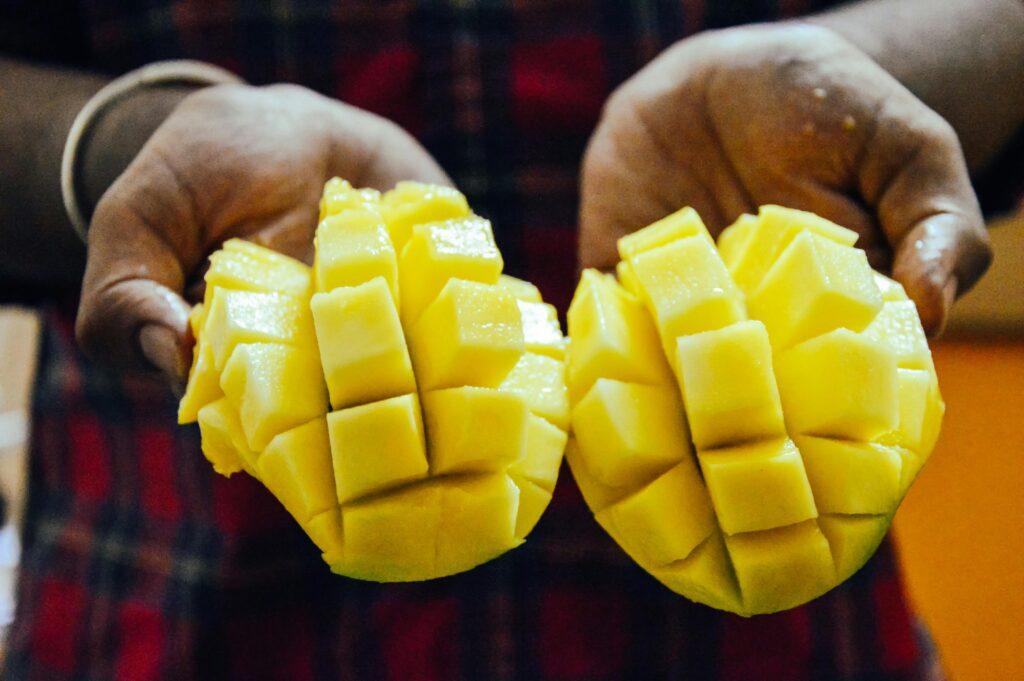Introduction:
Indian mangoes are not just fruits; they are ambassadors of taste, symbols of cultural richness, and bearers of heritage. With a plethora of varieties grown across the subcontinent, each mango type tells a story of its own, enticing consumers with its unique flavor, aroma, and texture. In this detailed exploration, we unravel the diverse tapestry of Indian mango varieties, offering a sensory journey through the orchards of India.
- Alphonso: The Jewel of Maharashtra
Origin and Significance:
The Alphonso mango, also known as “Hapus,” reigns as the undisputed king of Indian mangoes, originating from the lush orchards of Ratnagiri, Maharashtra. Its history can be traced back to centuries, with mention in ancient Indian texts and poetry.
Flavor Profile and Texture:
Alphonso mangoes are characterized by their velvety texture, vibrant saffron hue, and rich, buttery sweetness. When ripe, they emit a heavenly aroma, evoking notes of honey, apricot, and tropical bliss. The flesh is smooth and creamy, melting in the mouth with each indulgent bite.
Culinary Applications:
The Alphonso mango’s exquisite flavor and texture make it a favorite ingredient in a wide array of culinary creations. From traditional Indian desserts like mango lassi and mango kulfi to contemporary delights like mango cheesecake and mango salsa, Alphonso mangoes lend their unique sweetness and aroma to a multitude of dishes.
- Kesar: The Golden Gem of Gujarat
Introduction to Kesar Mango:
Named for its saffron-like hue and delicate fragrance, the Kesar mango is a prized variety grown in the verdant orchards of Gujarat. Known for its golden-yellow skin and luscious flesh, Kesar mangoes are cherished for their sweet, floral flavor.
Culinary Delights:
Kesar mangoes are revered for their culinary versatility and are used in a wide range of dishes and desserts. A popular Gujarati delicacy is Aamras, a sweet mango puree served with puris during festivals and celebrations. Additionally, Kesar mangoes are used to make mango shrikhand, a creamy yogurt-based dessert flavored with saffron and cardamom.
Seasonality and Availability:
The peak season for Kesar mangoes typically spans from April to June, with the fruit reaching its peak ripeness during this time. While Kesar mangoes are primarily consumed domestically in India, they are also exported to select international markets, albeit in limited quantities.
- Dasheri: The Pride of Uttar Pradesh
Overview of Dasheri Mango:
Hailing from the fertile orchards of Uttar Pradesh, the Dasheri mango is renowned for its succulent flesh, thin skin, and irresistible sweetness. Named after the village of Dasheri where it was first cultivated, this variety holds a special place in the hearts of mango lovers.
Culinary Versatility:
Dasheri mangoes are prized for their culinary versatility and are used in a variety of traditional Indian sweets and desserts. Mango phirni, a creamy rice pudding flavored with mango puree and aromatic spices, is a popular delicacy made with Dasheri mangoes. Additionally, Dasheri mango chutney is a beloved condiment served with savory snacks like samosas and pakoras.
Season and Harvest:
The peak season for Dasheri mangoes typically spans from May to July, with the fruit reaching its peak ripeness during this period. Farmers follow traditional harvesting practices, picking the mangoes at the perfect stage of ripeness to ensure optimal flavor and sweetness.
- Totapuri: The Tart Tang of South India
Introduction to Totapuri Mango:
Originating from the southern states of India, the Totapuri mango is distinguished by its elongated shape, tangy flavor, and firm texture. Named for its beak-like appearance resembling a parrot’s beak, Totapuri mangoes are prized for their unique taste and culinary versatility.
Savory and Sweet:
Totapuri mangoes are celebrated for their tangy flavor and are commonly used in savory dishes, chutneys, and pickles. Mango pickles made with Totapuri mangoes are a staple in South Indian cuisine, offering a burst of flavor and spice. Additionally, Totapuri mangoes are used to make refreshing mango smoothies and sorbets, balancing their tartness with sweetness.
Extended Harvest Season:
Unlike some other Indian mango varieties, Totapuri mangoes have an extended harvest season, spanning from April to July. This prolonged availability makes them ideal for procurement and consumption over an extended period, both domestically and internationally.
Conclusion:
In conclusion, the world of Indian mango varieties is a treasure trove of flavors, textures, and cultural heritage waiting to be explored. Whether savoring the velvety sweetness of Alphonso, the floral notes of Kesar, the succulence of Dasheri, or the tangy zest of Totapuri, each mango variety offers a unique sensory experience, inviting consumers on a culinary journey through the diverse landscapes of India. As exporters, buyers, and mango enthusiasts, let us embrace the richness of Indian mangoes and celebrate their unparalleled taste and heritage on a global stage.

